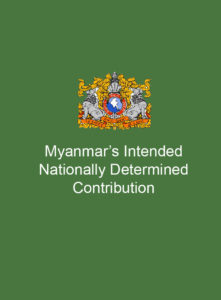Myanmar envisions that by 2030, the country can achieve climate-resilience and pursue a low-carbon growth pathway
to support inclusive and sustainable development.
Net Zero Target
for Forestry and Other Land Use (FOLU) sector
Myanmar envisions that by 2030, the country can achieve climate-resilience and pursue a low-carbon growth pathway
to support inclusive and sustainable development.
for Forestry and Other Land Use (FOLU) sector
Myanmar has several programs and plans in place to support their climate action plan. The country is working on the distribution of 5.1 million fuel-efficient cookstoves between 2021-2030 to carbon offsetting 10.25 million tCO2e. Other than that, the country is also embarking on providing electricity to the rural communities using RE technologies.
N/A
| Topic | Title | Year | Issuing Ministry |
Myanmar Climate Change Master Plan (2018-2030) |
2019 | Environmental Conservation Department, Ministry of Natural Resources and Environmental Conservation | |
| Myanmar Climate Change Strategy & Act Policy (MCCP) | |||
Myanmar Climate Change Strategy (2018-2030) |
2019 | Ministry of Natural Resources and Environmental Conservation | |
| Climate Change Initiatives, General brief on RE | National Environmental Policy (2019) |
2019 | The Republic of the Union of Myanmar |
| National Green Economy Policy Framework (GEPF) | |||
| Myanmar Sustainable Development Plan (2018-2030) | 2018 | Ministry of Planning and Finance | |
| Energy Outlook, Long-term planning | National Electricity Master Plan (2014) |
2015 | The Government of the Republic of the Union of Myanmar, National Energy Management Committee & Asian Development Bank |
Traditional biomass remains the domain, and the use of hydropower in TPES has increased drastically from 20% in 2015 to 47% in 2021. Myanmar has the potential for more than 100 GW of hydropower, of which only 3 GW has been developed so far. The largest potential is to be found in the Kayin, Shan, and Kayah states, where the Salween River is the major hydropower resource.
Traditional biomass and other renewables are the main consumers in TFEC, but since 2016 it has decreased. Otherwise, the amount of electricity used has been increasing gradually and this might indicate that the quality of modern energy service in the country has been improved.

Myanmar is identified as one of the most vulnerable countries in the world to climate change. Myanmar’s INDC has been submitted to the UNFCCC in 2015 and ratified the Paris Agreement in 2016. The INDC includes both mitigation and adaptation contributions. Mitigation targets mainly cover Forestry, Electricity, and Rural Renewable Energy sectors while adaptation contributions are in line with priority sectors in its NAPA (2012). The forestry sector is one of the most important sectors for mitigation actions and policies. Its targets are area based on the:
Currently, Myanmar is preparing to complete its NDC report in the coming months and submit UNFCCC in time. Myanmar as part of its NDC is committed to contributing to an unconditional reduction of emissions of 244.52 million tCO2e, and a total of 414.75 million tCO2e, subject to international financial conditions and technical support by 2030, this is in the framework of Myanmar’s efforts to control the impacts of global climate change based on the state of its country.